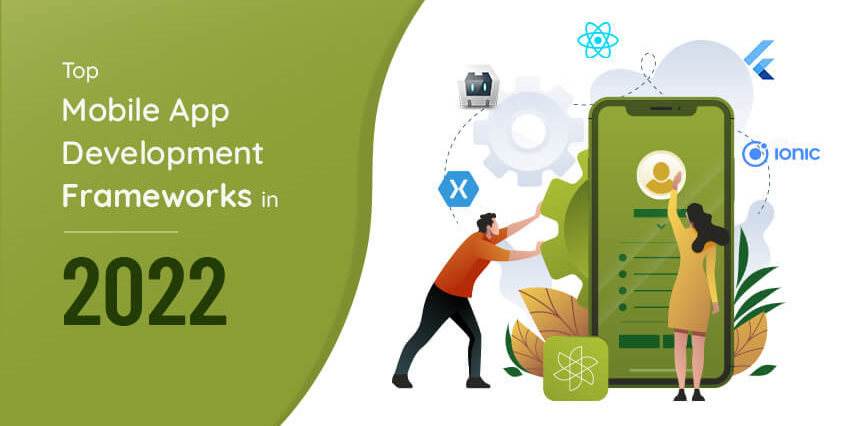Technology innovations have been a great help to ease people’s daily tasks. From appliances to transportation and communication, technology products continue to create comfort for those who use them. Today, it is not only about individuals maximizing technology; businesses too are using the power of mobile applications to boost their brands. Creating mobile applications is easier said than done. Businesses that look to create mobile applications need in-depth research, comprehensive planning, strategy creation, and analysis of the current mobile environment. One of the most vital components in developing mobile applications is mobile app development frameworks.
Mobile applications are vital for companies and businesses to keep up with competition and achieve optimal financial success in any industry. Mobile applications can effectively reach leads on primarily used channels such as mobile platforms where billions of people are accustomed to.
What is a Mobile App Development Framework?
A mobile app development framework is a collection of tools, libraries, and reusable components that provide a structured approach for building mobile applications. It serves as a foundation and provides developers with a set of pre-defined functionalities, allowing them to streamline the development process and accelerate app creation.
Frameworks simplify the app development process by providing ready-made solutions for common tasks, such as user interface design, data management, network communication, and device compatibility. They allow developers to focus more on the app’s logic and user experience rather than reinventing the wheel for every aspect of the development.
What are the top Mobile Development Frameworks in 2023?
Mobile application frameworks today have various built-in benefits such as a bug-free atmosphere, speed, and effectiveness. These frameworks already come with pre-built components like debugging tools, toolkits, and compilers to display applications on the desired device using the company’s code.
Here is a list of mobile development frameworks which can be very helpful and valuable for iOS and Android users.
React Native
React Native is an open-source, cross-platform framework developed by Facebook and was released in 2015 to improve the native Facebook application and other native mobile application experiences. This development framework has quickly become one of the most preferred options for programmers and developers because it enables quicker implementation and development.
If you wish to develop an application for both iOS and Android, React Native is an excellent tool for you. It can reduce the codebase by approximately 95%, which saves you time and money. The open-source libraries of pre-made components from React will help you speed up the development process. Furthermore, it has a smooth, slick, and responsive interface while reducing load time.
React Native is JavaScript-based, meaning developers need not long get grips with it. Third-party plug-ins and APIs, including payment systems and maps, can easily be integrated using React Native.
Flutter
This is another open-source development framework created by Google in 2017 to build mobile apps and consistently render 120 frames in a second. Just like Reactive Native, Flutter is generally advantageous since it is an open-source that offers cross-platform development. It is a precise and comprehensive framework that contains debugging and integrating APIs, a rendering engine, widgets, and other resources to assist programmers in building excellent mobile apps.
Flutter and React Native are two of the most widely used cross-platform frameworks in the market. While the two might be similar in several components, they both widely vary in development. Flutter provides a built-in navigator to help simplify the process for new developers. Its C++ rendering engine allows direct access to the interfaces, which leads to smooth and quick applications.
React Native, meanwhile, is created for experienced developers and needs a specific level of expertise. Skilled developers generally praise the efficiency of development from React. It provides JS code compiled to the native code, which invokes objective-C and the Java API. This then helps to display native components in Android and iOS.
In comparison, Flutter is better concerning performance, engineering cost, app features, compatibility, and other market trends. On the other hand, React Native is significantly better in terms of finding software developers.
Xamarin
The process of coding is quicker with Xamarin. Since this mobile app development framework employs the C# programming language, all the applications only need lesser lines of code. With this, it also allows rapid transfer of scripts across systems, like macOS and Windows.
Xamarin architecture comprises a virtual design platform to create native library support, testing suites, and a nugget-style component store. Their IDE provides iOS visual design to help developers from requiring opening X-Code.
Ionic
Ionic is another open-source mobile app framework generally used to create and develop hybrid mobile applications. These mobile apps are usually produced through web technologies. It is designed to be highly flexible to offer a development framework to create hybrid applications robustly and feasibly.
It is coded in JavaScript and allows developers to create applications customized for iOS, Android, Web browsers, Windows, and Desktop, distributed through native application stores and installed through Cordova. Ionic is considered developer-friendly as it interconnects a single source of code instead of developing a separate codebase for Android, iOS, and the web.
The most powerful and popular feature of Ionic is the ability for programmers to employ different UI components in the application development framework, which includes inputs, filtration, actions sheets, views, and easy navigation.
Apache Cordova
This is another hybrid mobile application development framework which was formerly called PhoneGap. The framework was developed by Nitobi and was purchased by Adobe Systems in 2011. Same with Ionic, developers and programmers use Apache Cordova to create hybrid mobile/web applications with the use of front-end web development languages.
It is a cross-platform development framework that builds mobile applications using HTML5, JavaScript, and CSS3. Meanwhile, the plugins in Apache Cordova allow developers to maximize smartphone features like camera, GPS, and accelerometer offering a native-like interface. A few of the excellent features of Apache Cordova include a quicker and easier production approach using a single code and a third-party app administration tool.
jQuery Mobile
The jQuery Mobile app development framework creates flexible web portals that can function on various platforms, such as tablet devices, PCs, and smartphones, utilizing HTML and JavaScript. It is a precise cross-platform development framework in two varieties: a stable framework and a customized version.
Developers are impressed with its Ajax-powered navigation system and touch-friendly UI widgets. This mobile app framework comes with ThemeRoller, a built-in tool that allows you to develop stunning application themes without writing a single line of code.
Final Thoughts
Deciding which framework to use for your mobile application will depend on several factors – a few of them will vary depending on your client’s or firm’s preferences, and others will depend on how you want the mobile application to work. The development framework must also address concerns on essential factors in a mobile app such as performance, speed, scalability, and security. The selection process of the development framework is a vital and critical step that will determine how programmers will develop the mobile app and how it will operate.
If you are looking to develop mobile application for your business, check our mobile application development services or Contact Us.
Other Related Articles You Might Be Interested In
Why is Flutter the Most Trending Hybrid Development Platform
React Native vs. Flutter: Which to Choose?
Mobile App Development Trends 2020








